(Reuters) – The Shiveluch volcano in Russia’s far eastern Kamchatka Peninsula erupted yesterday and sent up an ash plume 10 kilometers (six miles) high, posing an increased threat to air traffic, the Kamchatka Volcanic Eruption Response Team (KVERT) said.
The team issued a code red Volcano Observatory Notice for Aviation, noting that ash explosions 15 kilometers (9.32 miles)high could occur at any time. “Ongoing activity could affect international and low-flying aircraft,” it said.
The ash cloud following the eruption drifted to the west and south and measured 400 by 270 kilometers, the Kamchatka branch of the Geophysical Survey of the Russian Academy of Sciences said on Telegram. Russian media reports indicated it was continuing to spread.
Local authorities closed schools and ordered residents in nearby villages to stay indoors, head of the Ust-Kamchatsky municipal region Oleg Bondarenko said in a Telegram post.
One of Kamchatka’s largest and most active volcanoes, Shiveluch has had an estimated 60 substantial eruptions in the past 10,000 years, the last major one being in 2007.
It has two main parts, the smaller of which — Young Shiveluch — scientists have reported as being extremely active in recent months, with a peak of 2,800 meters (9,186 feet) that protrudes out of the 3,283 meter-high Old Shiveluch.
Bondarenko said the volcano erupted at 6:31 a.m. local time and that ash was falling on local villages including Klyuchi, where according to a TASS report quoting the Institute of Volcanology and Seismology, ashfall was measured at 8.5 centimeters (3.35 inches), the highest level in 60 years.
“Residents are advised to stay indoors and avoid unnecessary travel,” Bondarenko added.









